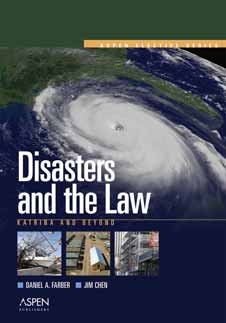Law among the ruins
Greetings from the third annual workshop of Syracuse University's Center on Property, Citizenship, and Social Entrepreneurship (PCSE). This year's PCSE workshop focuses on "legal and policy issues related to a major disaster":
In the wake of [hurricanes, earthquakes, floods and other disasters,] numerous issues arise. There are emergency response concerns, short-term housing issues, and planning for returning people to redeveloped long-term housing after the initial emergency is over. There are also many questions with respect to outstanding mortgages, refinancing, insurance, and title to property that come into play. There are environmental consequences, and redevelopment efforts raise concerns with respect to protection of cultural property, neighborhood identity and restoration, as well as reinvigorating civic institutions. Particular consideration must also be given to the needs of persons with disabilities. In all cases, questions arise with respect to pre-emergency planning, emergency response efforts, and post-emergency redevelopment.
 I have been given the honor of delivering the keynote speech at this workshop. PCSE director Robin Paul Malloy has invited me to base my presentation on Disasters and the Law: Katrina and Beyond. I will therefore take this opportunity to summarize this book (which I edited alongside Dan Farber) and to cast it as a legal blueprint for dealing with future disasters.
I have been given the honor of delivering the keynote speech at this workshop. PCSE director Robin Paul Malloy has invited me to base my presentation on Disasters and the Law: Katrina and Beyond. I will therefore take this opportunity to summarize this book (which I edited alongside Dan Farber) and to cast it as a legal blueprint for dealing with future disasters.Let us begin with first principles. Disaster is never natural. Catastrophic losses invariably stem from social as well as environmental factors. Social injustice contributes so heavily to the incidence and intensity of natural disasters that the quest for equality should be rightfully regarded as a valuable tool for refining the law’s approach to disaster preparedness, response, mitigation, compensation, and recovery.
 These legal responses to disaster, in turn, hinges on social resilience. Susan Cutter astutely observes that "[s]ocial vulnerability is partially a product of social inequalities -- those social factors and forces that create the susceptibility of various groups to harm, and in turn affect their ability to respond, and bounce back (resilience) after the disaster." Whereas susceptibility to harm is already in place when disaster strikes, resilience, assumes importance after the fact. Rebuilding communities destroyed by disaster demands extraordinary human and material resources. See generally Mapping Vulnerability: Disasters, Development and People (Greg Bankoff et al. eds., 2003).
These legal responses to disaster, in turn, hinges on social resilience. Susan Cutter astutely observes that "[s]ocial vulnerability is partially a product of social inequalities -- those social factors and forces that create the susceptibility of various groups to harm, and in turn affect their ability to respond, and bounce back (resilience) after the disaster." Whereas susceptibility to harm is already in place when disaster strikes, resilience, assumes importance after the fact. Rebuilding communities destroyed by disaster demands extraordinary human and material resources. See generally Mapping Vulnerability: Disasters, Development and People (Greg Bankoff et al. eds., 2003).The entire battery of legal tools designed to prevent and mitigate natural disaster, outlined in chapter 6 of Disasters and the Law, might therefore be profitably reimagined as the law's solution to minimizing social susceptibility before the next natural event becomes a social catastrophe. As we look forward, the present looms large. To name but one example, critical infrastructure in New Orleans remains dangerously thin. Health care facilities are particularly precarious.
 In light of a traditional commitment to federalism and to thorough delegation of police powers to state and local governments, the United States' legal structure for emergency response is extraordinarily convoluted. Although this structure has begun to change (see Dan Farber's assessment of the "Post-Katrina Act of 2006" and of that statute's amendments to the Stafford Act, as well as my assessment of the new 21st Century Emergency Communications Act), two basic features of emergency response remain intact. First, emergency response remains in the first instance the responsibility of state and local governments. (Consider, in this connection, the question of federal versus state responsibility for flood control.) Second, the federal law of emergency response retains the mark of the Homeland Security Act, which reorganized FEMA within a bureaucratic structure dedicated in the first instance to responding to terrorism and acts of war, and only secondarily to natural threats.
In light of a traditional commitment to federalism and to thorough delegation of police powers to state and local governments, the United States' legal structure for emergency response is extraordinarily convoluted. Although this structure has begun to change (see Dan Farber's assessment of the "Post-Katrina Act of 2006" and of that statute's amendments to the Stafford Act, as well as my assessment of the new 21st Century Emergency Communications Act), two basic features of emergency response remain intact. First, emergency response remains in the first instance the responsibility of state and local governments. (Consider, in this connection, the question of federal versus state responsibility for flood control.) Second, the federal law of emergency response retains the mark of the Homeland Security Act, which reorganized FEMA within a bureaucratic structure dedicated in the first instance to responding to terrorism and acts of war, and only secondarily to natural threats.In focusing on federalism and more traditional problems related to the reconciliation of federal and state authorities, we should not overlook promising solutions for coordinating state and local response authorities on a peer-to-peer basis, for empowering private-sector providers of infrastructure to act on behalf of the public, and for enabling response coordinators (whatever their source of legal authority) to identify and implement emergent solutions. We might do well to explore international human rights law as a potential source of standards for the treatment of internally displaced persons.
One of the most dynamic areas of the law of disasters is the enormous task of reconstruction. One of the most wrenching issues is the question of how to rebuild New Orleans. An urban planner's preferred "footprint" routinely demands the bulldozing of an old neighborhood. Perhaps this is merely a variation on one of the oldest themes in urban planning: aggressive zoning versus relatively unplanned growth. But it behooves us, I think, to consider whether urban planning might be leavened by an emergent alternatives that would allow self-organizing agents to read feedback loops and to incorporate new information into the reconsideration of prior decisions.
 And this is to say nothing of future disasters. Could Sacramento be the next New Orleans? Climate change, pandemics, what else? Frightening though it may be to contemplate, are we merely in the eye of an ongoing global storm, set off by anthropogenic climate change?
And this is to say nothing of future disasters. Could Sacramento be the next New Orleans? Climate change, pandemics, what else? Frightening though it may be to contemplate, are we merely in the eye of an ongoing global storm, set off by anthropogenic climate change?I close with one plea. Assessing the law of disasters at a high level of abstraction shares one pitfall with the quantitatively intense task of determining what works and what doesn't. We should never reduce the many individual tragedies involved in any disaster to mere ideas, whether they are couched as legal doctrines or as statistics, and thereby numb our ability to empathize with the victims as human beings. This indeed is the highest calling of law -- and love -- among the ruins.












0 Comments:
Post a Comment
<< Home